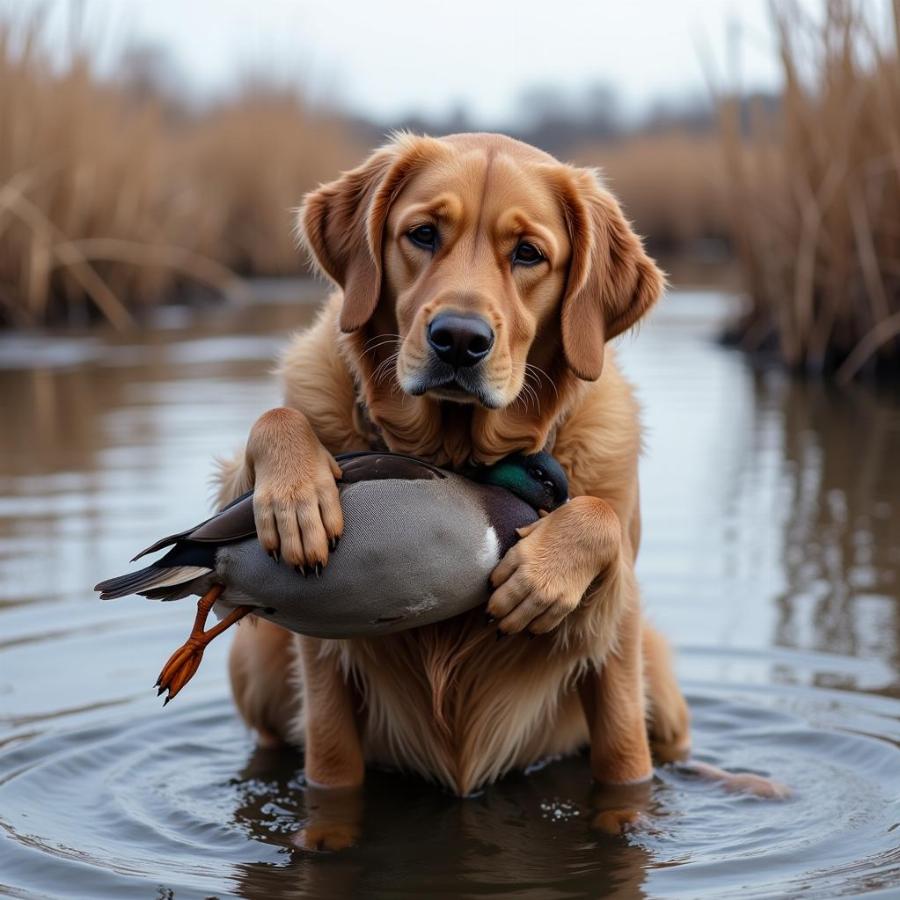Waterfowl hunting dogs are essential partners for any serious hunter. These highly skilled canines are bred for their retrieving abilities in challenging watery environments, making them invaluable for bringing down ducks, geese, and other waterfowl. Choosing the right breed and providing proper training and care are crucial for success and a harmonious partnership. This comprehensive guide will explore the world of waterfowl hunting dogs, covering everything from breed selection to essential gear and training tips.
Choosing the Right Waterfowl Hunting Dog Breed
What breed is best for you? Several factors influence this decision, including your hunting style, the terrain you typically hunt, and your personal preferences. Some breeds excel in icy waters, while others thrive in warmer climates. Certain breeds are known for their gentle nature, while others possess a more independent spirit. Let’s explore some of the most popular waterfowl hunting dog breeds:
- Labrador Retrievers: Known for their intelligence, trainability, and friendly disposition, Labs are a perennial favorite. Their thick coats provide insulation in cold water, and their strong retrieving instincts make them highly effective in the field.
- Golden Retrievers: Another popular choice, Golden Retrievers are intelligent, eager to please, and possess a soft mouth, ideal for retrieving delicate game.
- Chesapeake Bay Retrievers: “Chessies” are tough, rugged dogs built for the harshest conditions. Their waterproof coat and powerful build make them exceptional in icy waters.
- Nova Scotia Duck Tolling Retrievers: “Tollers” are smaller than Labs or Goldens, known for their unique hunting style that involves luring waterfowl within range of the hunter.
- American Water Spaniels: Versatile and energetic, American Water Spaniels are adept at retrieving in dense cover and are well-suited for hunters who frequent smaller bodies of water.
 Labrador Retriever retrieving a duck
Labrador Retriever retrieving a duck
Essential Gear for Your Waterfowl Hunting Dog
Equipping your canine companion with the proper gear is crucial for their safety and performance. A duck dog vest provides warmth in cold water and visibility in dense cover. A sturdy leash, a reliable whistle, and a comfortable dog blind are also essential.
What’s more important than a good vest? Protecting your dog’s paws. Sharp rocks, ice, and other debris can injure your dog’s pads. Consider investing in dog boots specifically designed for hunting. These boots offer protection and improve traction on slippery surfaces.
Training Your Waterfowl Hunting Dog
Training your waterfowl hunting dog requires patience, consistency, and positive reinforcement. Start with basic obedience commands like “sit,” “stay,” and “come.” Gradually introduce retrieving exercises, beginning with bumpers and progressing to live birds.
How do you introduce your dog to water retrieves? Begin in shallow water and gradually increase the depth as your dog gains confidence. Use positive reinforcement and encouragement to build their enthusiasm for retrieving. Advanced training can include blind retrieves and handling commands for directing your dog in the field. For more information on specific breeds and their training needs, consider checking out resources on best pheasant hunting dogs.
Health and Care for Waterfowl Hunting Dogs
Maintaining your dog’s health is paramount. Regular veterinary checkups, vaccinations, and parasite prevention are crucial. After each hunt, thoroughly check your dog for injuries, paying close attention to their paws, ears, and coat. A healthy diet rich in protein and essential nutrients is vital for sustaining their energy levels and supporting their immune system. You might also be interested in learning more about poodles for hunting dogs.
What are some common health issues to watch for? Ear infections, hypothermia, and cuts from sharp objects are common concerns for waterfowl hunting dogs. Be vigilant and address any issues promptly.
Conclusion
Waterfowl hunting dogs are more than just hunting companions; they’re members of the family. Choosing the right breed, providing proper training and care, and equipping them with the right gear will ensure a successful and enjoyable hunting experience for both you and your canine partner. If you’re considering adding a waterfowl hunting dog to your life, remember that the rewards of this partnership extend far beyond the field.
FAQ
- What is the best age to start training a waterfowl hunting dog? Training can begin as early as 8 weeks old, focusing on basic obedience and socialization.
- How often should I train my waterfowl hunting dog? Short, frequent training sessions are more effective than long, infrequent ones. Aim for 15-20 minutes of training several times a week.
- What kind of food should I feed my waterfowl hunting dog? A high-quality dog food formulated for active breeds is recommended. Consult with your veterinarian for specific dietary recommendations.
- How do I keep my dog warm during cold-weather hunts? A duck dog vest and waterproof boots are essential for cold-weather hunts.
- Where can I find duck dogs for sale? Reputable breeders and rescue organizations are good places to start your search. You may also find resources online for hunting dog communities.
Related Topics:
- Dog Training Tips
- Waterfowl Hunting Regulations
- Choosing the Right Hunting Gear
Beaut Dogs is your ultimate resource for everything related to dog breeds, care, and training. From labradoodle hunting dog information to expert advice, we’re here to help you provide the best possible care for your canine companion. When you need assistance, please contact Email: [email protected] to get detailed and accurate answers from Beaut Dogs. Beaut Dogs – your trusted source for all things canine.